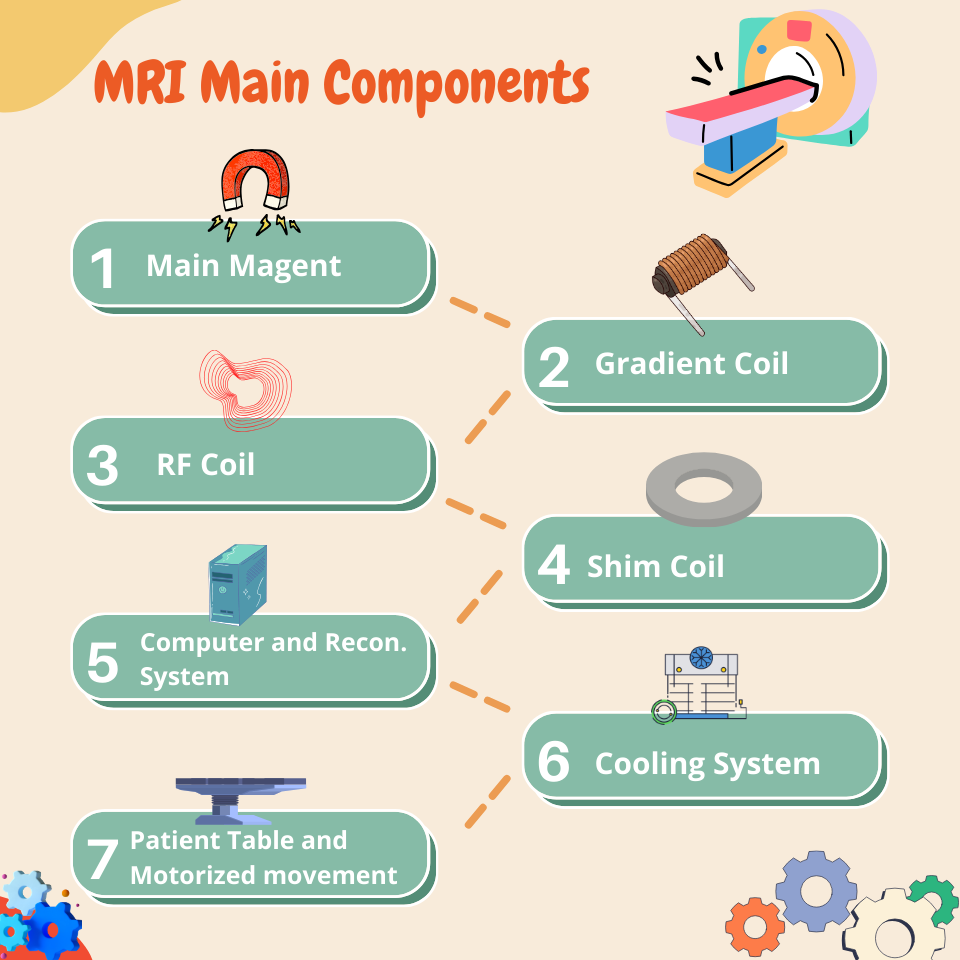MRI stands out as one of the most advanced diagnostic tools in modern medicine, enabling one to get images of internal body structures very clearly. But how does this incredible machine work, and what what are the parts of an MRI machine? This blog post gives an in-depth look at the major constituent parts making up an MRI machine, complete with descriptions of the role each plays.
Introduction to MRI Machines
MRI machines use very strong magnetic fields, radio waves, and advanced computer systems to generate detailed images of soft tissues, bones, and organs. The functions of an MRI machine-and hence, its capabilities-are better appreciated with some knowledge of its parts.
Main Magnet: The Heart of MRI Systems

It is the most basic and key part of an MRI machine, where this main magnet produces a very strong uniform magnetic field that aligns the hydrogen nuclei or simply protons inside the human body to produce the MRI images.
Main magnet, which aligns protons in a particular direction hence creating the possibility of imaging.
Types of magnets:
- Superconducting Magnets: By far the most common are superconducting magnets; these have high field strength and stability, being cooled by liquid helium (-273 Celsius !!).
- Permanent Magnets: These are utilized in open MRI systems. Although these have lower field strength, they are more patient-friendly for claustrophobic patients.
Gradient Coils: Spatial Encoding in MRI
MRI signals can, in turn, be spatially encoded since the gradient coils are able to alter the magnetic field strength.
It essentially furnishes the magnetic field with the applied gradients required by the hardware to accurately localize the positions of the protons in the body.
Key Applications:
- Slices of the body are differentiated.
- Changing the resolution and orientation of images.
RF Coils: RF coils radiate and receive the signals
RF coils fundamentally provide the action of transmitting radiofrequency pulses and receiving the emitted signals from the body.
Types of RF Coils:
- Surface Coils: Used for imaging small, localized areas such as wrists or knees.
- Volume Coils: wrap around larger areas, such as the torso or the head.

These coils serve for the imagers to excite the protons and detect the signals emanating from them for processing into images.
Shim Coils – Magnetic Field Homogeneity
Shim coils fine-tune the magnetic field’s uniformity, which is essential for high-quality imaging.
Purpose: To correct magnetic field inhomogeneities induced either by patient anatomy or hardware.
This is made homogeneous by adjustments with active and passive shimming techniques.
Computer Systems and Software: Where the Brain of MRI Operations Resides
In MRI, computing systems perform the following three major roles: hardware control, data processing, and image reconstruction.
Functions:
- Synchronize RF pulse and gradient sequences.
- Data processing to provide high-definition, full-resolution images.
Advanced features include AI-based enhancements using the latest MRI software for faster and more accurate image processing.
MRI Performance Systems Maintenance: Cooling Systems
Due to cooling systems, the main magnet keeps staying superconducting.
- Cryogenic Cooling: The superconducting magnets cool by liquid helium. The process does not disrupt the machine’s process.
- Pitfalls in Cooling: Efficient Helium Management-Reducing System Downtime at Pitrinec.
Patient tables and positioning accessories
The comfort and accuracy of the scanning depend a lot on the patient table.
Design Features:
- Motorized movement allowing precision in position.
- Weight and height adjustment for comfort.
Importance: This will minimize motion artifacts and ensure better quality of imaging.
Safety Features of Magnetic Resonance Equipment
MRI machines have many built-in safety features in order to protect both patients and operators.
- Magnetic Field Safety: Procedure to avoid the entry of ferromagnetic objects into the MRI room.
- Emergency shutdown systems include immediate turn-off in an emergency of the magnetic field.
- Comfort Features of the Patients Noise reduction technology Claustrophobic patients.
Because every part of MRI, from the large magnet aligned by protons to the computer system responsible for its processing and reconstruction, is imperative in performing the scans, it all goes into one integrated, smooth, sophisticated system, helpful for diagnosis in the most varied conditions involving different organs. Learn more.
Knowledge of the parts of an MRI not only underlines its technological wonder but also gives reason for maintenance and upgrading in these machines, so as to realize their optimum performance. Learn more about MRI technology or get professional advice on medical imaging devices with Technomed Medical Parts and Equipment (TEMPE).


